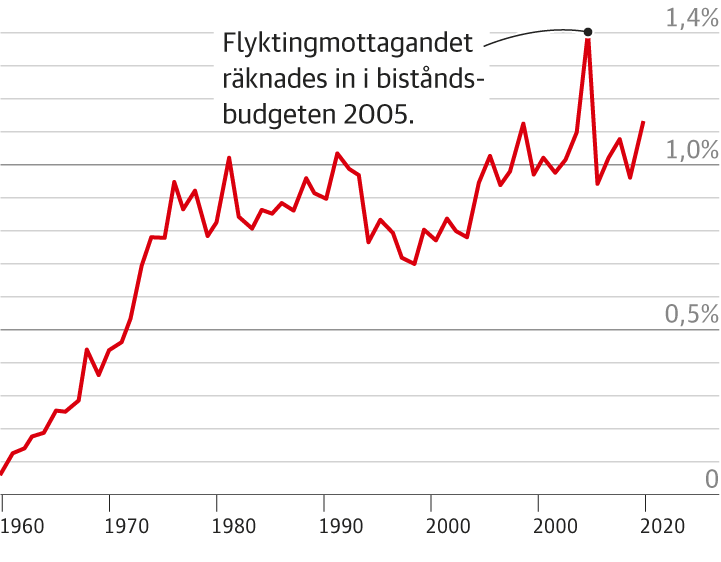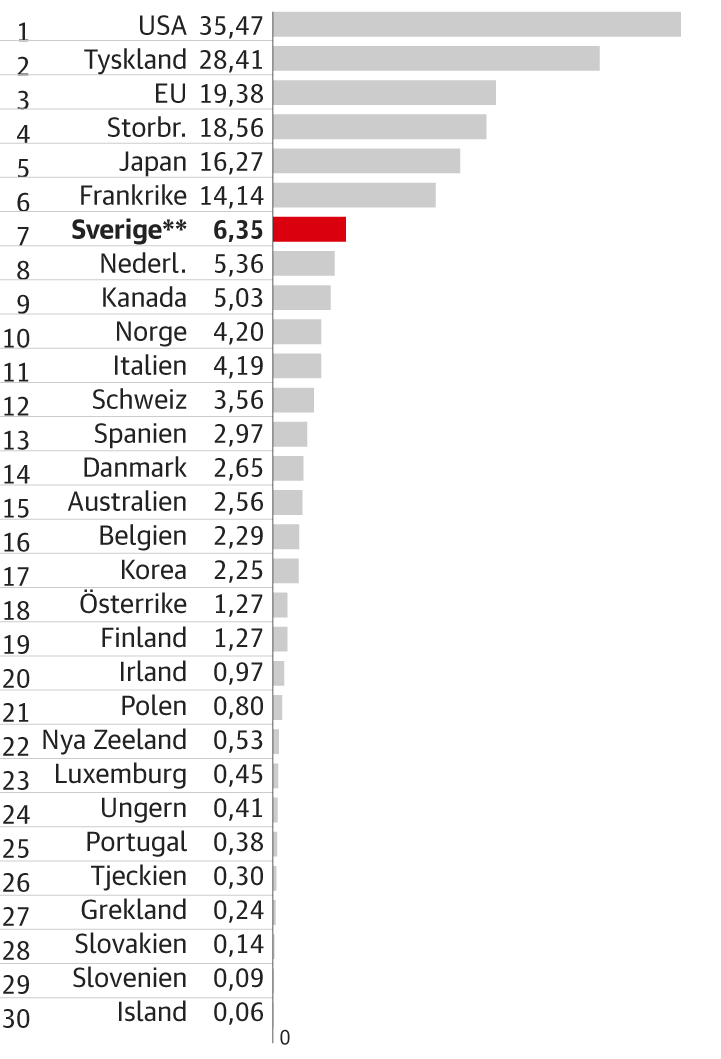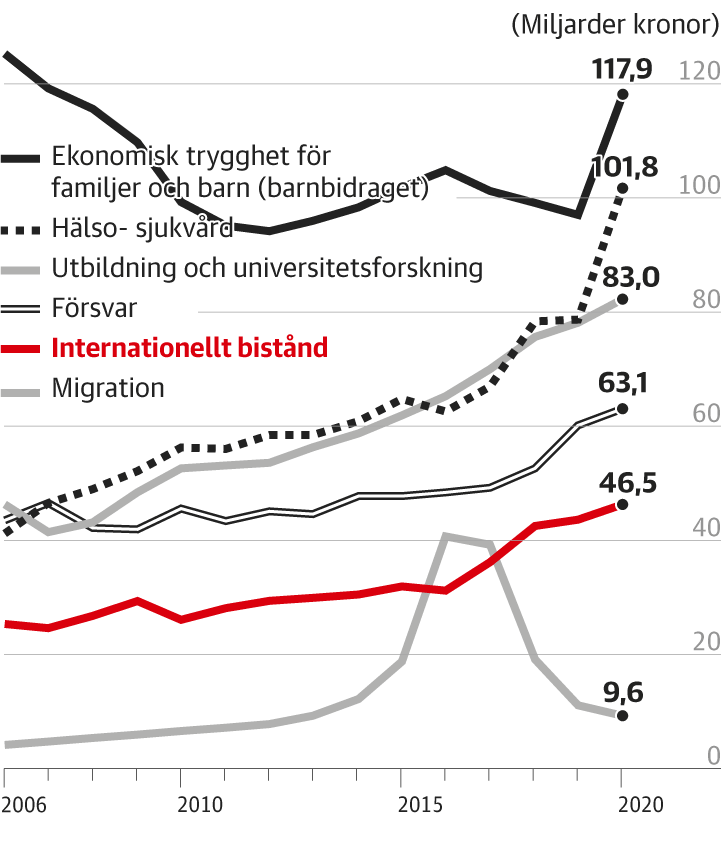I Sponsored posts On Facebook, the Moderates are sending their message, through several local Facebook groups, in mid-January of this year. Economic Policy spokeswoman Elizabeth Svantison pictured with her eyes in the camera.
“Reduce aid. We have big problems at home.”
Sweden should cut several billion kroner from its development aid budget every year, according to the moderates’ proposal. The more than 50-year-old goal of Swedish development aid – to provide one percent of GDP, GNI – must be abandoned.

In a school in Dhaka, many toilets have been built, partly funded by Swedish aid.
Photo: Paul Hansen
A few weeks later, the new Swedish aid minister, environmental expert Per Olson Friede, made his first trip abroad as a minister in the Rohingya refugee camp in Bangladesh – a country that received around 500 million Swedish kronas from Sweden in 2020 – and looks into his affairs. Mobile camera. A group of children running around it.
– To go here and meet these little kids, the size of the kids I have at home, smile and laugh, but know their future is more difficult – it’s difficult. But we are here to do what we can. We shouldn’t be disappointed, he says, in the video to be posted on Instagram.
Swedish Development Aid as a Percentage of GNI 1960-2020
Graphics: DN Source: Ekonomifakta / Ekonomistyrningsverket
It should help to drop Because of the pandemic – or an increase? The question not only divides the Swedish debate, but the whole world. Several countries have cut aid budgets in the wake of the pandemic. The UK is cutting development aid by the equivalent of 47 billion Swedish kronor, or nearly the entire Swedish development aid budget, due to the crisis. Several other countries are making similar cuts.
At the same time, aid organizations are sounding the alarm about the greatly increased need for support in the world’s poor countries. The World Bank warns Extreme poverty is now rising for the first time in more than 20 years, with nearly 120 million people. At least 83 million others are malnourished, According to the United Nations Food and Agriculture Organization (FAO).
The warnings caused several other countries, including Sweden, Norway, Canada, France and Germany to instead increase their aid in 2020. Thanks to this, global aid reached an all-time high last year, at $ 161.2 billion, according to New assembly from OECD. And most of all, counted as a share of the economy, Sweden gave it – 1.14 per cent of GDP.
Aid for 2020 as a percentage of the country’s GDP
Graphics: DN Source: OECD
Billions of dollars in 2020 2020 *
Charts: DN Source: OECD * The average dollar exchange rate in 2020 was 9.20 SEK per dollar. ** The OECD DAC has a different Swedish Development Assistance number for 2020 than ESV because it measures in different ways, including when it comes to payment time for development assistance. The costs of receiving asylum are also included in the statistics of the Development Assistance Committee of the Organization for Economic Cooperation and Development.
But the question is How long will Sweden stay there? The DN has asked all the parliamentary parties how to stand on the one percent goal – which is strongly questioned by some parties.
Three clear camps crystallize.
First: Those who want to make a real reduction in the budget for development aid. Here M and SD.
● Second: Those who claim that the 1 percent target should be fixed, such as S, L, and KD.
● Third: Those who believe that development aid in times of crisis may increase as a percentage of GDP, so that the shrinking Swedish economy does not cause the development aid budget to suddenly contract. Here C, MP and V.
MP and V have the most generous line that the one percent goal should be “floor.” The Left Party also wants to contribute another billion annually for two years, “to reduce the spread of infection, meet urgent health care needs, and counter the effects of the epidemic.”

Bangladesh is one of the countries that will receive the most aid from Sweden, around 500 million Swedish kronor in 2020. This is about half of what Afghanistan, the largest recipient country, gets.
Photo: Paul Hansen
Climate assistance is another thing A clear dividing line. All parties except SD want to increase climate aid – but not everyone is willing to follow the agreement in the UN climate negotiations that climate aid should be “additional”, that is, in addition to the usual aid.
Clearly, only the Left Party must be additional climate aid. The party wants to set aside another 2.25 billion 2021-2023 specifically for the climate. The MP believes that increasing the GDP by itself means that climate assistance will be additional, while S believes that all aid above 0.7 percent can be considered additional. L, M, C, and KD believe that other aid should be prioritized to increase climate aid.
In the future where we get immigration policy in order, we can imagine going back to a higher level of development aid
The Swedish Democrats don’t want to increase climate aid at all and are also the party that wants to cut aid the most. The party wants to lower the level to 0.5 per cent of GDP, clearly lower than the 0.7 per cent level set by the world’s nations as a target in a United Nations resolution from 1970. With higher priority given, says Oscar Seusted, economic policy spokesman at SD. .

Oscar Seusted, Economic Policy Spokesperson, SD.
Photo: Beatrice Lüneburg
You said earlier that Sweden should “help there” instead of receiving so many asylum seekers. How does it align with Half Aid?
We will still have a high level of assistance in international comparison. And in the future when we get immigration policy in order, we can imagine going back to a higher level of development aid.
The largest recipient of Swedish aid …
… and the biggest areas of spending
Graphics: DN Source: Openaid
M and SD demands to reduce development aid cause all parties in January to react strongly to the DN poll. The newly appointed Swedish Minister for Development Aid, environmental expert Per Olsson Friede, believes that cutting aid from Sweden would be a betrayal of the outside world.
We are witnessing an increase in poverty, major health challenges, pervasive climate change, and an ecosystem in crisis. These are challenges that no one can solve on their own, and we can only do so if we collaborate globally. In this case, the desire to reduce the conditions that allow Sweden to participate in this cooperation – I think that means a step back from our responsibility.
One should know that reducing aid will have consequences, both for Sweden’s role in the world and for people who need help
Aid is one of the largest budget lines and the amount increases automatically year after year. How do you see the criticism directed at it?
– The needs are great in the world. Even if all countries in the world provided a percentage of the aid, it would cover only a tenth of the needs. I understand that those who feel that life is difficult in Sweden think that we should spend more resources at home and less on others. But one must know that reducing aid will have consequences, both for Sweden’s role in the world and for people who need help.
Swedish development assistance in relation to other items of spending
Graphics: DN Source: Ekonomifakta / Ekonomistyrningsverket
The question now is what will happen in the event of a change of government in the 2022 elections – potentially a moot issue if M and KD win the election. While M and SD want to reduce development aid, KD and L are strong advocates of maintaining the 1% target. The question is clearly sensitive in both M and KD. M does not want to comment on how she agreed with the intended government partner on the issue of development assistance – and KWD changes her answer in the questionnaire. First, the party opens up to be able to get help sometimes higher than one percent to avoid “jerk”. Then the party retracts that formulation and is convinced that it cares about the current model. In the spring, ex-party leader Alf Svenson has it too Openly criticized Moderates suggestion.
The Swedish Democrats state that the party will work for its streak in any negotiations.
Then we will see where such negotiations end, says Oscar Seusted (SD).
This is how the parties like to help
DN asked all parliamentary parties how they view the level of development aid, whether climate assistance should be increased, and whether climate assistance should be additional (new funds be added to the existing development aid budget).
Graphics: DN * M believes any additional liabilities should be “tested on a case-by-case basis”. ** S believes climate aid is indeed additional as all aid exceeding the UN target of 0.7 percent of GNI could be considered additional. *** MP thinks climate assistance is already additional because the 1% target means the development aid budget grows as GDP grows.
Read more:
Discuss DN. “We want to give development aid a clear green and liberal agenda.”
Martin Libby Troin: A really rotten idea for the moderates to cut aid now

“Falls down a lot. Internet fanatic. Proud analyst. Creator. Wannabe music lover. Introvert. Tv aficionado.”











More Stories
More than 100 Republicans rule: Trump is unfit | World
Botkyrka Municipality suspends its directors after high-profile trip to New York
Huge asteroid approaching Earth | World